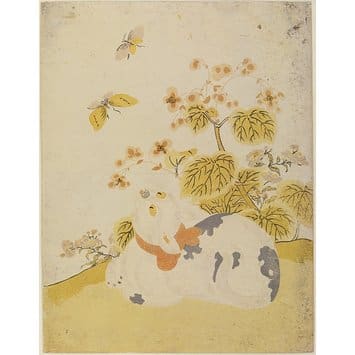
Cats in Japanese Woodblock Prints
Interested in selling a Japanese woodblock print?
We have received top dollar for Japanese woodblock prints. Auction is the best way to quickly and transparently get maximum dollar for your artwork.
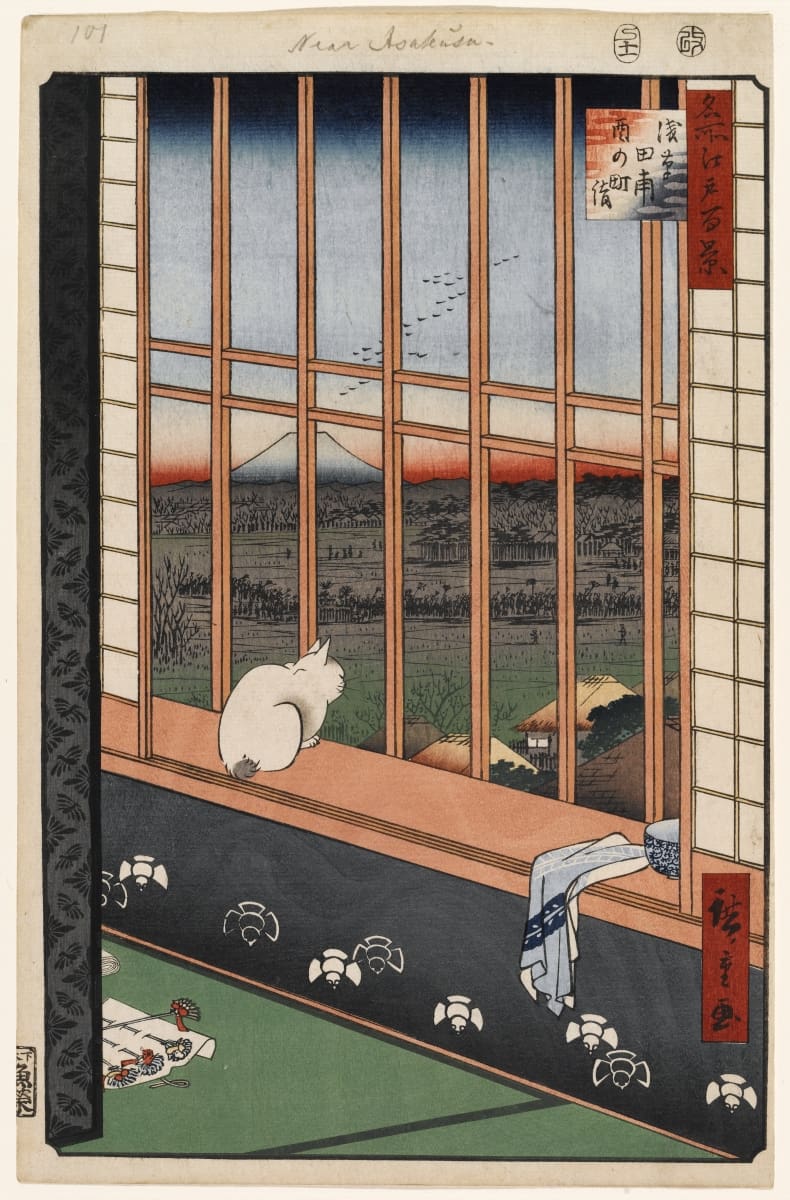
Asakusa Ricefields and Torinomachi Festival
Utagawa Hiroshige, 1857
Wikimedia Commons
Cats in Japanese Woodblock Prints
Ukiyo-e artists throughout the Edo period explored a variety of genres, including historical events, kabuki actors, folk tales, beautiful women, and the natural environment. One recurring subject in Japanese woodblock prints that encompasses multiple genres is cats. The first domesticated cats in Japan can be dated back to the sixth century BCE when they arrived as companions of Buddhist monks traveling from China. Tasked with protecting sacred texts from mice during their journey, the cats had an unprecedented effect on the locals, who became infatuated with them.
The role of felines in Japan can be seen in the art produced throughout the following centuries, most notably in the woodblock prints that became popular in the 1600s. They are depicted in countless ways, whether anatomically correct or heavily stylized; cute or frightening; anthropomorphic or realistic in behavior. The purpose of cat imagery further differs among artists and time period. Some works are meant to be fun and playful, while others are meant to teach a lesson or even serve as a political statement.
In the 1857 print, Asakusa Ricefields and Torinomachi Festival (Asakusa tanbo Torinomachi môde), Utagawa Hiroshige used a cat as the focal point of an idealistic depiction of 19th century Tokyo. It was a part of Hiroshige’s famous series, One Hundred Famous Views of Edo (Meisho Edo hyakkei), and remains among the artist’s most popular works. This print shows the comfortable life of a domesticated cat, living indoors with a bowl of water or food to its right, enjoying the view of the city.
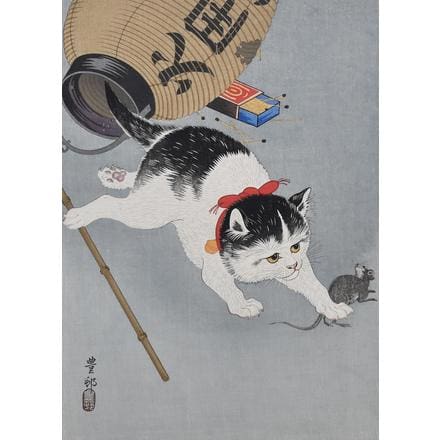
Untitled
Ohara Koson, early 20th c.
American Studio Ceramics and Fine Estates Auction July 18, 2019
Sold: $500
Another example of a naturalistic cat can be seen in this untitled early 20th century woodblock print by Ohara Koson, in which a mischievous cat is depicted behaving true to its nature as it chases after a mouse. The cloth around its neck points to its domesticity, and its well-groomed appearance adds to the overall impression of a playful, happy creature. Koson is well-known for his realistic and colorful renderings of animals, a characteristic of the “shin-hanga” movement he was a part of. Kawanabe Kyosai’s Cat and Mouse (c. 1930s) further shows the revitalization of traditional woodblock prints in the “shin-hanga” movement.
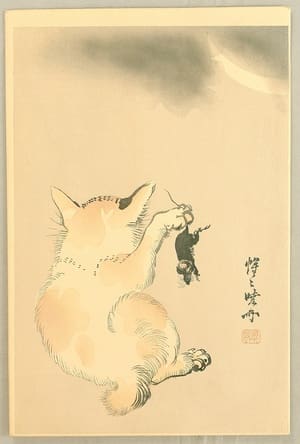
Cat and Mouse
Kawanabe Kyosai, c. 1930s
Ukiyo-e.org

A Hundred Cats’ Physiognomies
Utagawa Kuniyoshi, 1842
Kuniyoshi Project
Other artists took a much different approach by depicting anthropomorphized cats in Japanese woodblock prints. In many cases, this is done simply because it is entertaining to see cats doing human things. At other times, however, there is a deeper meaning behind the human-like qualities. In the early 1840s, the Tokugawa Shogunate enacted the Tenpō Reforms, which banned images of geishas, kabuki, and courtesans, as leaders wanted to distance society from these so-called “luxurious” professions. As a result, artists like Utagawa Kuniyoshi improvised by replacing humans with cats in scenes that would otherwise be censored. Kuniyoshi is known above all other ukiyo-e artists as a cat lover. He kept them as pets throughout his life, and was known to keep many in his studio. His fascination with the animal manifested itself in numerous works containing clever, pointed adaptations of cats in varied styles and forms. In the 1842 print, A Hundred Cats’ Physiognomies (Neko no hyaku men-sô), Kuniyoshi portrays famous actors from the seventh act of the popular Kabuki play, Chûshingura, in the form of cats. Those familiar with the actors and play could identify each figure from the clothing, mannerisms, and hairstyles (“fur”) of the cats. Kuniyoshi’s ability to produce playful, yet contentious, themes speaks to the unique role of ukiyo-e in Japanese society as both art and pop culture.
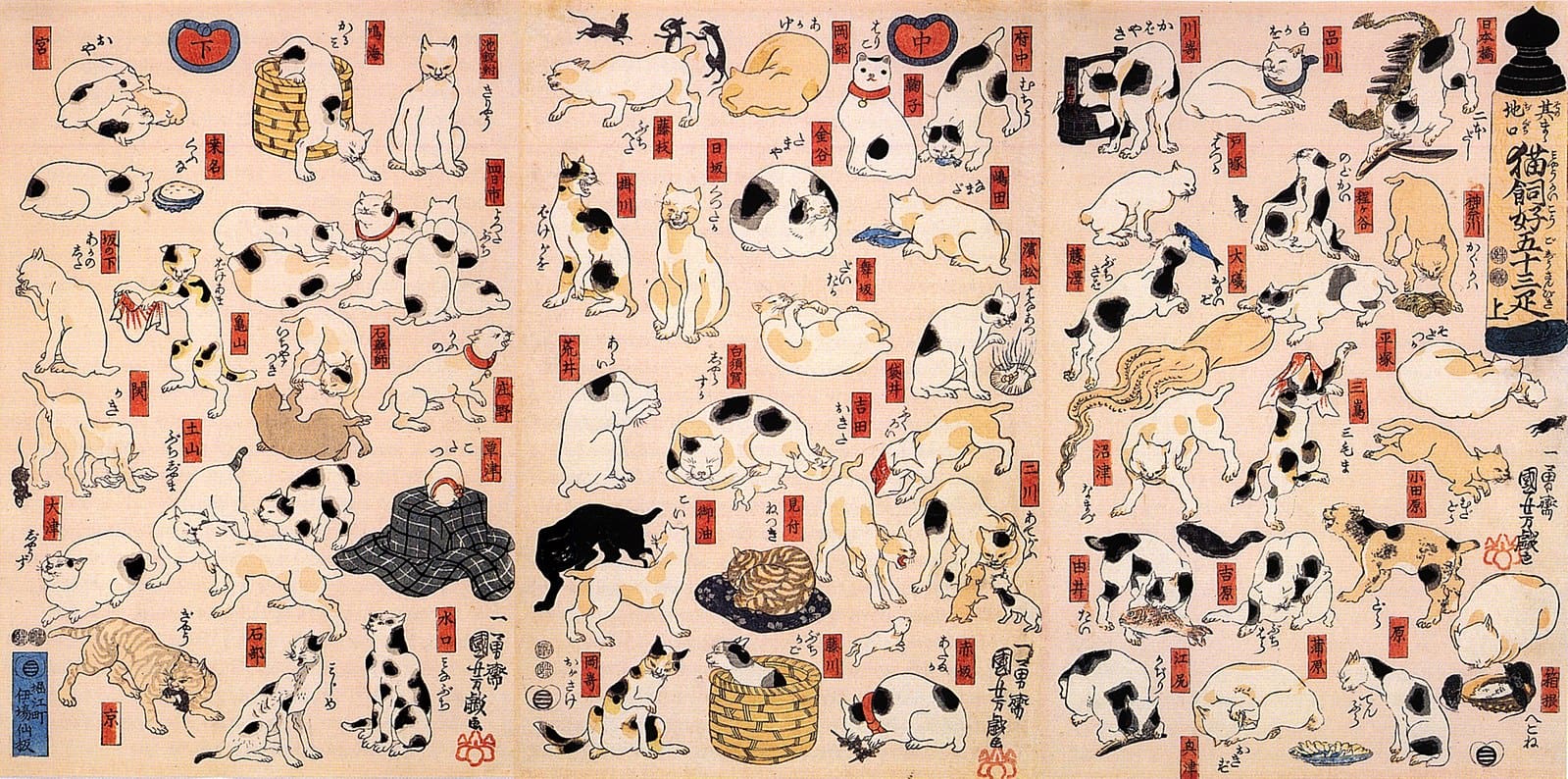
Cats Suggested As The Fifty-three Stations of the Tōkaidō
Utagawa Kuniyoshi, 1850
Wikimedia Commons
The human-like figures Kuniyoshi created in response to the Tenpō Reforms were only one of many ways he portrayed cats. Some of Kuniyoshi’s most famous works are lighthearted, humorous renderings of felines in their natural forms. In this triptych, Cats Suggested As The Fifty-three Stations of the Tōkaidō (1850), Kuniyoshi uses cats to represent each of the individual stations depicted in Hiroshige’s infamous series from decades before, The Fifty-three Stations of the Tōkaidō (1833-1834). Each cat reflects one of the fifty-three stations along the road connecting Kyoto and Tokyo.
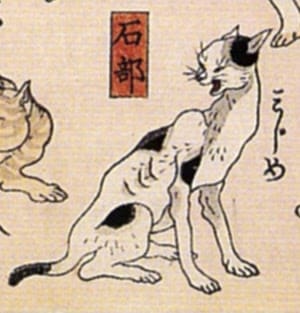
Closeup of The Fifty-first Station
The appearance and behavior of the cats are presented as puns, hinting at the characteristics of each station. For example, the name of the fifty-first station, Ishibe (石部), sounds similar to miji-me (ミじめ), the Japanese word for ‘miserable.’ In Kuniyoshi’s print, the fifty-first cat appears sickly and emaciated as it lets out a hiss–the embodiment of misery.

Catfish
Utagawa Kuniyoshi, 1841
Kuniyoshi Project
He took a more direct play on words and imagery in his 1841 print, Catfish (namazu) なまず. Upon first glance, the spotted figures resemble koi fish; it is only after closer examination that one can identify the skillfully positioned feline forms. Kuniyoshi took the pun a step further by arranging the cats to form the shape of the characters of “na,” “ma,” and “zu,” which together mean “namazu,” the Japanese word for catfish.

War of Cats and Mice
Tsukioka Yoshitoshi, 1859
Museum of Fine Arts Boston; William Sturgis Bigelow Collection
Not all woodblock prints featuring cats fit into a single category of representational style. Yoshitoshi’s series, War of Cats and Mice (Neko nezumi kassen), tells a dramatized story of natural enemies engaged in human-like fighting. “Cats Tempted by a Delicious Smell” (above) and “Mice Eating While Cat Sleeps” (below) feature cats and mice wearing traditional Samurai armor engaged in a humorous rivalry reminiscent of Tom and Jerry.
In many cases, cats in Japanese woodblock prints are more than just a decorative feature to fill space. Clever artists used a seemingly simple subject to create everything from heartwarming domestic scenes to sharp social commentary, rebellion, and humor. The diverse ways in which feline imagery was used in Japanese woodblock prints points to the skill, creativity, and grit of ukiyo-e artists, and highlights the range and flexibility of ukiyo-e as a genre.
If you have Japanese woodblock print you wish to have appraised or sold please get in touch for a free auction estimate.